We use cookies to make your experience better. To comply with the new e-Privacy directive, we need to ask for your consent to set the cookies. Learn more.
Create a Poem
Have you ever noticed that while it is easy to recognize poetry, describing it can be difficult? That is because poetry can take so many different forms and styles. This book is intended to teach the elements of lighter poetry to students and have them practice using those elements in their own poetry writing, all in a fun and easy-going way. It is divided into seven sections that deal with increasingly difficult forms of poetry and provides worksheets for those forms. Each form of poetry covered includes a description and sample of what the form entails and then instructs students to write their own poem using the style of writing they just observed.
The first section includes beginning activities to get students interested in poetry and warm up their skills with easier poem forms. They learn about and write such poems as acrostic poems, "I am" poems, and jingles. The second section of the book discusses the shape of poetry. Students learn about writing poems using stanzas and create shapes with their poems like pyramid poems, diamond poems, and column poems. The third section of the book teaches and provides practice in traditional poetry, free verse, narrative poetry, and lyric poetry. The forth section of the book shares the elements of poetry. Students learn about and write similes, metaphors, under and overstatement, personification, figures of speech, alliteration, and more. The fifth section teaches how to acquire and develop ideas for writing poetry. It includes a list of brainstorming and revision ideas as well as actual topics to write about. Section six in the book includes ideas on how teachers can showcase their students' poetry. Ideas include having a poetry reading, making a poetry notebook, and recording student poems on tape recorders or video cameras. The final section displays small poems from actual third to tenth grade students from around the country. Reproducible. ~ Rachel S.
These materials cover various types of creative writing, including descriptive writing, poetry, journaling, and stories.
These materials include both writing instruction and writingassignments.
| Product Format: | Softcover Book |
|---|---|
| Brand: | NetPub |
| Author: | Eleanor W. Hoomes |
| Grades: | 4-8 |
| ISBN: | 9781587763267 |
| Length in Inches: | 11 |
| Width in Inches: | 8.5 |
| Height in Inches: | 0.25 |
| Weight in Pounds: | 0.55 |

